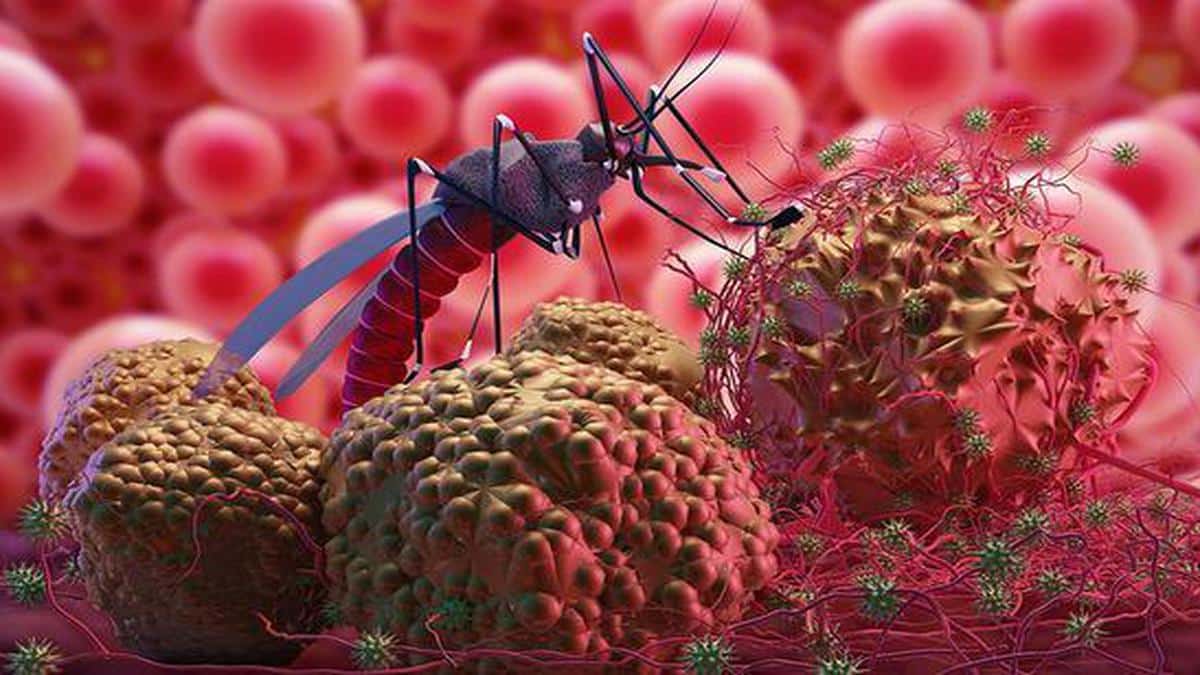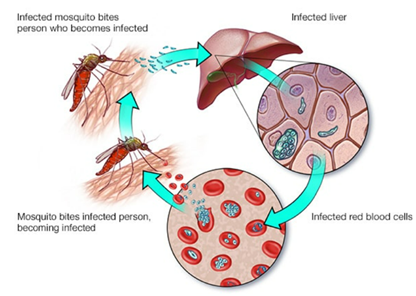What’s in Today’s Article?
- Why in the News?
- About Malaria
- How Malaria is Spread?
- About World Malaria Report 2023
- What does the Report say About India?
- Steps Taken by Government of India to Control Malaria
Why in the News?
- The World Health Organisation (WHO) published a report titled ‘World Malaria Report 2023’.
About Malaria
- Malaria is a disease caused by the Plasmodium parasite.
- The parasite can be spread to humans through the bites of infected mosquitoes.
- The plasmodium parasite is spread by female Anopheles mosquitoes, which are known as “night-biting” mosquitoes because they most commonly bite between dusk and dawn.
- There are many different types of plasmodium parasite, but only 5 types cause malaria in humans.
- Plasmodium falciparum – mainly found in Africa, it’s the most common type of malaria parasite and is responsible for most malaria deaths worldwide.
- Plasmodium vivax – mainly found in Asia and South America, this parasite causes milder symptoms than Plasmodium falciparum, but it can stay in the liver for up to 3 years, which can result in relapses.
- Plasmodium ovale – fairly uncommon and usually found in West Africa, it can remain in your liver for several years without producing symptoms.
- Plasmodium malariae – this is quite rare and usually only found in Africa.
- Plasmodium knowlesi – this is very rare and found in parts of southeast Asia.
How Malaria is Spread?
- The plasmodium parasite is spread by female Anopheles mosquitoes, which are known as “night-biting” mosquitoes because they most commonly bite between dusk and dawn.
- Once a person is bitten, the parasite enters the bloodstream and travels to the liver.
- The infection develops in the liver before re-entering the bloodstream and invading the red blood cells (RBCs).
- The parasites grow and multiply in the RBCs. At regular intervals, the infected blood cells burst, releasing more parasites into the blood.
- If a mosquito bites a person already infected with malaria, it can also become infected and spread the parasite on to other people.
- However, malaria does not spread directly from person to person.
About World Malaria Report 2023
- Each year, WHO’s World malaria report provides a comprehensive and up-to-date assessment of trends in malaria control and elimination across the globe.
- Trends in the global malaria burden:
- This year’s report highlights that despite strides in expanding access to insecticide-treated nets and medicines to help prevent malaria in young children and pregnant women, more people were getting sick with malaria.
- Giving the global picture and trends in Malaria the report stated that in 2022, there were estimated 249 million cases globally, exceeding the pre-pandemic level of 233 million in 2019.
- Threat of Climate Change:
- This year’s report includes, for the first time, a dedicated chapter focused on the intersection between climate change and malaria.
- Changes in temperature, humidity and rainfall can influence the behavior and survival of the malaria-carrying Anopheles mosquito.
- Extreme weather events, such as heatwaves and flooding, can also directly impact transmission and disease burden.
- Catastrophic flooding in Pakistan in 2022, for example, led to a five-fold increase in malaria cases in the country.
- Conflict and humanitarian crises, resource constraints and biological challenges such as drug and insecticide resistance also continue to hamper progress.
- Positive Takeaway:
- The report cites achievements such as the phased roll-out of the first WHO-recommended malaria vaccine, RTS, S/AS01, in three African countries.
- In October 2023, WHO recommended a second safe and effective malaria vaccine, R21/Matrix-M.
- The availability of two malaria vaccines is expected to increase supply and make broad-scale deployment across Africa possible.
- There has also been progress toward malaria elimination in many countries with a low burden of the disease. In 2022, 34 countries reported fewer than 1000 cases of malaria compared to just 13 countries in 2000.
What does the Report say About India?
- According to the World Malaria Report, India accounted for 66% of malaria cases in the World Health Organization’s South-East Asia region in 2022.
- India and Indonesia accounted for about 94% of all malaria deaths in the region last year, the World Health Organization said.
- The report said that nearly 46% of all cases in the region were caused by Plasmodium vivax, a protozoal parasite and a human pathogen.
Steps Taken by Government of India to Control Malaria
- Since 2000, India cut malaria cases by more than half and the number of malaria deaths by more than 66%.
- In 2016, India introduced its first National Framework for Malaria Elimination (2016-2030).
- It has a vision of a malaria-free country by 2027 and elimination by 2030.
- In 2019, the Government of India increased funding by more than 25% for the National Vector Borne Disease Control Programme and increased support as a donor to the Global Fund to Fight AIDS, Tuberculosis and Malaria.
Q1) What are Communicable Diseases?
Communicable diseases are illnesses caused by viruses or bacteria that people spread to one another through contact with contaminated surfaces, bodily fluids, blood products, insect bites, or through the air.
Q2) Why is it difficult to develop an effective malaria vaccine?
Malaria parasites have a complex life cycle, and there is poor understanding of the complex immune response to malaria infection. Malaria parasites are also genetically complex, producing thousands of potential antigens.
Source: In 2022, India accounted for 66% of malaria cases in WHO South-East Asia Region: World Malaria Report | WHO
Last updated on January, 2026
→ Check out the latest UPSC Syllabus 2026 here.
→ Join Vajiram & Ravi’s Interview Guidance Programme for expert help to crack your final UPSC stage.
→ UPSC Mains Result 2025 is now out.
→ UPSC Notification 2026 is scheduled to be released on January 14, 2026.
→ UPSC Calendar 2026 has been released.
→ UPSC Prelims 2026 will be conducted on 24th May, 2026 & UPSC Mains 2026 will be conducted on 21st August 2026.
→ The UPSC Selection Process is of 3 stages-Prelims, Mains and Interview.
→ Prepare effectively with Vajiram & Ravi’s UPSC Prelims Test Series 2026 featuring full-length mock tests, detailed solutions, and performance analysis.
→ Enroll in Vajiram & Ravi’s UPSC Mains Test Series 2026 for structured answer writing practice, expert evaluation, and exam-oriented feedback.
→ Join Vajiram & Ravi’s Best UPSC Mentorship Program for personalized guidance, strategy planning, and one-to-one support from experienced mentors.
→ UPSC Result 2024 is released with latest UPSC Marksheet 2024. Check Now!
→ UPSC Toppers List 2024 is released now. Shakti Dubey is UPSC AIR 1 2024 Topper.
→ Also check Best UPSC Coaching in India


















